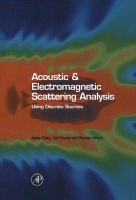Browse content
Table of contents
Actions for selected chapters
- Full text access
- Book chapterAbstract only
I - Elements of functional analysis
Pages 1-15 - Book chapterAbstract only
II - The scalar Helmholtz equation
Pages 17-38 - Book chapterAbstract only
III - Systems of functions in acoustic theory
Pages 39-66 - Book chapterAbstract only
IV - Discrete sources method in acoustic theory
Pages 67-92 - Book chapterAbstract only
V - Null-field method in acoustic theory
Pages 93-106 - Book chapterAbstract only
VI - The Maxwell equations
Pages 107-135 - Book chapterAbstract only
VII - Systems of functions in electromagnetic theory
Pages 137-193 - Book chapterAbstract only
VIII - Projection methods in electromagnetic theory
Pages 195-201 - Book chapterAbstract only
IX - Discrete sources method in electromagnetic theory
Pages 203-239 - Book chapterAbstract only
X - Null-field method in electromagnetic theory
Pages 241-298 - Book chapterNo access
Appendix - Programmes on the Internet
Page 299 - Book chapterNo access
References
Pages 301-312 - Book chapterNo access
Index
Pages 313-317
About the book
Description
The discrete sources method is an efficient and powerful tool for solving a large class of boundary-value problems in scattering theory. A variety of numerical methods for discrete sources now exist. In this book, the authors unify these formulations in the context of the so-called discrete sources method.
The discrete sources method is an efficient and powerful tool for solving a large class of boundary-value problems in scattering theory. A variety of numerical methods for discrete sources now exist. In this book, the authors unify these formulations in the context of the so-called discrete sources method.
Key Features
- Comprehensive presentation of the discrete sources method
- Original theory - an extension of the conventional null-field method using discrete sources
- Practical examples that demonstrate the efficiency and flexibility of elaborated methods (scattering by particles with high aspect ratio, rough particles, nonaxisymmetric particles, multiple scattering)
- List of discrete sources programmes available via the Internet
- Comprehensive presentation of the discrete sources method
- Original theory - an extension of the conventional null-field method using discrete sources
- Practical examples that demonstrate the efficiency and flexibility of elaborated methods (scattering by particles with high aspect ratio, rough particles, nonaxisymmetric particles, multiple scattering)
- List of discrete sources programmes available via the Internet
Details
ISBN
978-0-12-219740-6
Language
English
Published
2000
Copyright
Copyright © 2000 Elsevier Ltd. All rights reserved
Imprint
Academic Press
